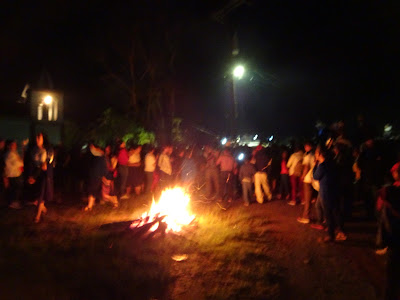Our parish has more than 40 different places for community worship, mostly churches in the widely scattered towns and villages. Almost all the villages have Delegates of the Word who lead Sunday celebrations; more than twenty Communion Ministers serve in the countryside.
Devotion to the Eucharist is strong – even though there are not many who receive Communion with regularity (though this is changing).
Where there is a communion minister there is usually a Holy Hour every Thursday – and, in some places, exposition and adoration for several hours. Before the pandemic, we had days of prayer with exposition of the Eucharist every other month in the ten rural sectors of the parish. We began the year of the pandemic, 2020, with a theme of peace and reconciliation.
Corpus Christi is therefore very special.
As has been the case for several years, Corpus Christi has been preceded by Forty Hours of Adoration.
I remember this devotion from my youth, where the altar boys would be scheduled for at least an hour before the exposed Eucharist. Parishioners would come for an hour, some in the middle of the night.
Here some communities have forty continuous hours of adoration. Other places, having found it difficult in the past to have people come in the middle of the night, scheduled forty hours over three days.
In some areas where there are not communion ministers, the ministers arranged to be in communities for between three and ten hours during the day so that all communities would have the opportunity to spend time before the exposed Eucharist. In many of these the ministers visited the sick. In some there were processions.
I was available to go to communities where there is no communion minister, but the communion ministers had arranged visits to almost all the villages in the parish.
 |
| Oromilaca where they had forty continuous hours of Eucharistic adoration |
In a few sectors of the parish, the forty hours ended with Mass, preceded by a procession. We stopped at five altars for prayer and, where a priest or deacon was present, Benediction with the Blessed Sacrament.
On Friday I went to Delicias Concepcion where people from two sectors of the parish gathered.
Sunday morning I went to Oromilaca where they ended forty continuous hours with a procession and a Celebration of the Word with Communion.
Sunday afternoon, I went to Mass in San Agustín where Mass was preceded by a procession around the central square. At Mass, twenty-one children from eight to thirteen received their first communion. (Needless to say it was a long afternoon.)
Since the pastor had participated in several processions over the course of the week, he asked me to carry the monstrance for part of the processions in Delicias Concepción and in San Agustín.
In each place we had five altars with prayers related to the situation of migrants. I wrote about this in an earlier post.
Our pastor, a Guatemalan, rooted in the popular piety of his hometown, sees the importance of connecting liturgy and popular devotions with the lived reality of the people. Each year our parish stations of the cross connect pointedly with the reality of life here. So, this year he asked me to prepare the prayers at the altar with the reality of migration in mind.
The reflections are quite strong. (The Spanish text can be found here.) But I shared them with the communion ministers who would be leading the reflections in the processions in different parts of the parish during their monthly meeting. One woman noted that though they were pointed they revealed the reality of what people experience – why they leave, what they experience on the journey and when they arrive, what those who are left behind feel.
Pointedly, we prayed at one altar for four groups of refugees, inviting people to name those they knew: those who have died in the US, those who are on the road at this time; those who are living in other countries (most notably the US and Spain); and those who have returned (by their own will or deported).
Sunday morning, in one village, they mentioned more than 30 persons who have migrated, several who have died, some who are now on the road, and a few who have returned. I thought of a good number of people whom I know who are in the US as well as some who have been returned. I remembered several distraught families whose family members have been kidnapped and held for ransom in Mexico.
 |
| Benediction at an altar in Dulce Nombre in front of a mural on refugees. |
The reality is hard for all concerned.
We pray that Christ will sustain migrants and their families – and that the nations of the world will open their hearts and their borders to those in need, with just, non-discriminatory migration laws.
We began the procession with the prayer of Pope Francis for the 2022 World Day of Prayer for Migrants and Refugees. This is a good way to end this post.
Lord, make us bearers of hope,so that where there is darkness, your light may shine, and where there is discouragement, confidence in the future may be reborn. Lord, make us instruments of your justice, so that where there is exclusion, fraternity may flourish, and where there is greed, a spirit of sharing may grow. Lord, make us builders of your Kingdom, together with migrants and refugees and with all who dwell on the peripheries. Lord, let us learn how beautiful it is to live together as brothers and sisters. Amen.
 |
| Mural of migrants, Dulce Nombre de Copán |



















